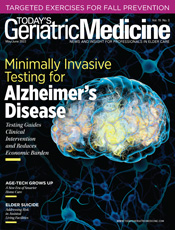
May/June 2022
The Last Word: Patients With Delirium Are Too Often Diagnosed With Dementia Because the symptoms of delirium and dementia may seem to overlap, patients experiencing the former are frequently misdiagnosed as having the latter. Without a proper diagnosis of delirium and an investigation into its underlying causes, those patients may never get appropriate treatment and their symptoms may become permanent. It’s a costly mistake that’s associated with increased morbidity and hospital stays and reduced quality of life. At least 20% of the 12.5 million patients older than 65 years who are hospitalized each year experience complications due to delirium, which is often a consequence of pain and hospitalization. Delirium is an acute condition or a sudden change in mental state. It can be either hyperactive—characterized by agitation, restlessness, hitting, or yelling—or hypoactive—indicated by flat affect, withdrawal, apathy, lethargy, and decreased responsiveness. Delirium occurs when the normal signals to and from the brain become impaired. It occurs more commonly in patients older than 65. Pain can be a contributing factor to the delirium that’s often mistaken for dementia. That delirium may also be caused by a urinary tract or other infection or a sudden change in environment. For example, hospital admissions, room changes, invasive procedures, poor lighting, lack of sleep, alarms, and speaking in different languages all can contribute to or worsen delirium. With proper management of the underlying cause, delirium can be treated and the patient can be returned to baseline. For patients with pain, proper utilization of pain assessment tools along with appropriate pain management can result in a pain relief and, consequently, a resolution of the symptoms of delirium. A multifactorial approach, which combines direct observation, caretaker input, consideration of known pain-producing conditions, and evaluation of response to treatment, is recommended. As a nurse practitioner, I observed how many patients were being misdiagnosed with dementia, and I wanted to bring about a change. I filmed vignettes of several patients to educate staff and illustrate this complex assessment. A common occurrence in these patients was unaddressed trauma, which caused the delirium. I was able to show the staff that by treating the pain with acetaminophen or ibuprofen, I could return the patients to their baseline cognitive levels. In order to manage the delirium and prevent misdiagnosis, I evaluated older adults who were diagnosed with dementia, assessed them using the Pain Assessment in Advanced Dementia (PAINAD) scale, and had purposeful discussion with caretakers regarding medical history and cognitive and functional status. Typically, new and concerning behaviors brought patients to the hospital—for example, a gentle person who began hitting or yelling, or a person who was uncommunicative and appeared as an “empty shell.” Often, such patients are diagnosed with dementia based on their age and behavior, not on their medical history. In order to correctly diagnose delirium, health care providers must talk to the patients’ caretakers and explore the patients’ medical histories (both past and present) before jumping to a diagnosis of dementia simply based upon age or an isolated incident. Delirium requires careful evaluation of pain or other sources of distress. Assessing geriatric patients who present with sudden changes in behaviors with the correct pain scale—the PAINAD scale—is crucial to help rule out dementia and thus decrease the number of nursing home placements. In the absence of self-report, observation of behavior is a valid approach to gauging a patient’s pain, but keep in mind the facial expressions of pain in those with cognitive impairment is not necessarily the same as that of people who are not impaired. They may, for example, exhibit a smile, an angry face, or a lack of affect. If there’s an underlying history of fractures, falls, or traumas, assume the patient is in pain. If patients exhibit behaviors such as crying, hitting, or swearing, consider that may be the only way they’re able to communicate pain. And to help prevent delirium, providers can avoid prescribing benzodiazepines to older adults. Several studies show these can cause an increase in falls, which in turn drive up the risks of fractures and pain, leading to delirium. My research in acute/long term care facilities has shown that offering Tylenol, administered around the clock, can make a difference. These changes are crucial to protecting our patients from the consequences of misdiagnoses. — Samantha A. Undari-Schwartz, NP, MSN, APRN, AGNP-C, ANP-C, is dual certified as a nurse practitioner in adult care and geriatrics and has worked in geriatrics, palliative care, and pain management for many years. |
